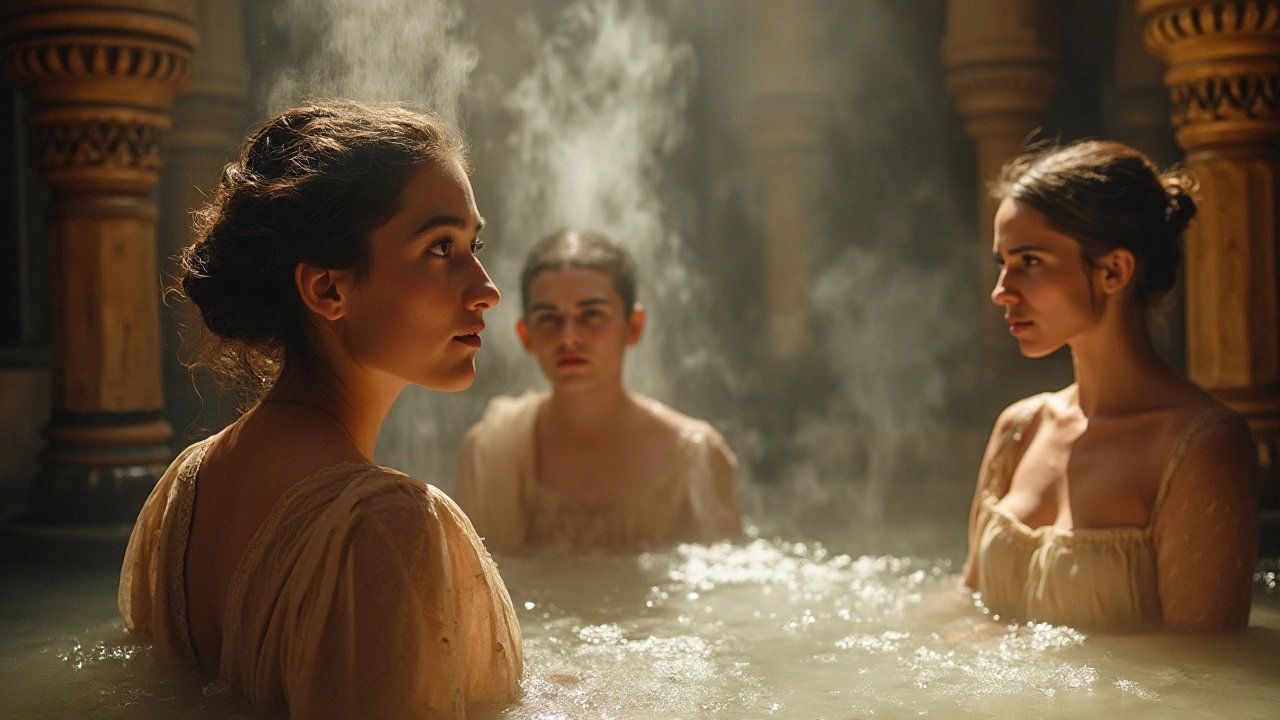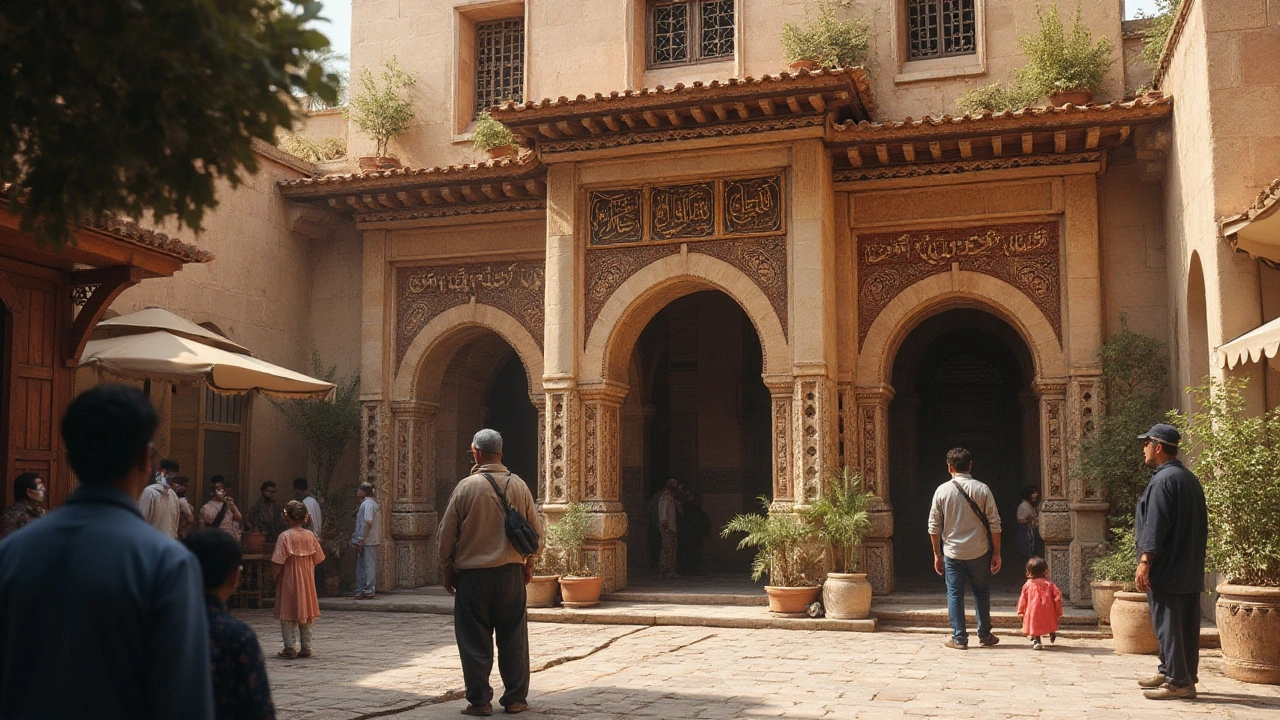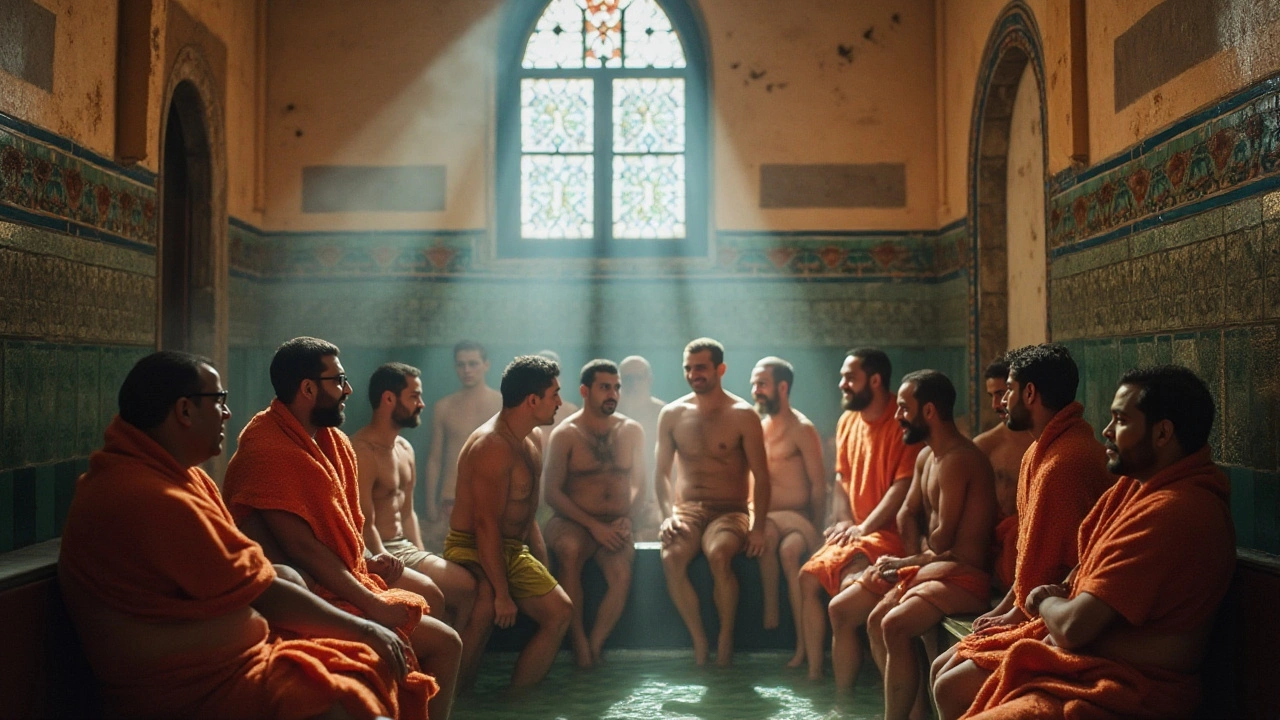In the heart of Middle Eastern cities, hidden behind ornate doors and elaborate facades, lies a world of warmth and communal harmony: the hammam.
Historically, these traditional bathhouses, often found in bustling towns and serene villages alike, have served as crucial social hubs. They offer a sanctuary from the everyday rush, where one can not only cleanse the body but also rejuvenate the soul.
Over the centuries, the hammam has evolved yet retained its cultural essence, creating an inviting atmosphere that intertwines history, architecture, and human connection in a truly unique way.
- The Origins of the Hammam
- Architectural Significance
- Rituals and Practices
- Social and Cultural Importance
- Modern-Day Hammam Experiences
The Origins of the Hammam
The hammam, with its steamy allure and communal spirit, is a venerable institution steeped in history, reaching back to the days of ancient Rome and Byzantium. These bathhouses were more than just places to wash; they were community centers where news was exchanged and stories were shared, creating a tapestry of life that was both functional and social. The evolution of the hammam in the Middle East began with the Roman thermae, grand structures which boasted heated rooms and magnificent architecture. As the Islamic world expanded, these bathhouses adapted, incorporating Islamic customs and spiritual rituals, becoming integral to the day-to-day life of the people.
Islamic culture places a high importance on cleanliness, both physical and spiritual, and the hammam became the perfect embodiment of this belief. Often located near mosques, they offered a practical means to maintain the purity required for prayer. A visit to the hammam was more than personal hygiene; it was a ritual purification, a preparation for the sacred. In many cities, the building itself stood as a symbol of luxury and generosity, often built by affluent members of the community who sought to leave a legacy of wellbeing and hospitality.
The design of a traditional hammam typically includes three interconnected rooms: a hot room to open the pores and cleanse with heat, a warm room for washing, and a cool room for relaxation. The architectural beauty of these baths is evident in their domed roofs, intricate tile work, and ambient lighting that creates a serene environment. These elements played a crucial role in ensuring the hammam was not just a place of cleansing but of restoration and tranquility, where the sound of water echoes off the walls, enveloping visitors in calm.
In some regions, the construction and support of a hammam were so significant that they were funded by charitable endowments, known as waqf, ensuring they remained accessible to all layers of society. This act of philanthropy was seen as an essential duty, enhancing the social fabric by providing a haven for everyone, from the wealthy merchant to the humble traveler. According to the words of the medieval Moroccan traveler Ibn Battuta, "In every city, there is a setting where all come equal, for the steam obscures no class, and the water guards no secrets." These bathhouses, thus, were not just marvels of engineering but vessels of cultural unity.
The story of the hammam is a testament to the endurance of tradition and the enduring quest for a balanced life. It represents an art form that has survived through centuries, a reflection of societal norms and values. Whether in the bustling city centers of Istanbul or the quiet streets of Marrakech, the hammam remains a timeless bridge between the past and the present.
Architectural Significance
The architectural design of a hammam is a magnificent portrayal of artistic ingenuity and cultural symbolism, reflecting the climatic needs and social functions of the region. A traditional hammam often comprises three main sections: the cold room, or frigidarium, the warm room, also known as tepidarium, and the hot room, called caldarium. Each space serves a distinct purpose, blending utility with comfort, and maintaining a journey-like transition from the outer world’s chaos to an inner sanctum of relaxation and reflection.
Typically, the entrance leads to a large cold room where bathers adjust to the humidity and warmth gradually. Often circular or octagonal in shape, these spaces sometimes feature a domed ceiling adorned with a constellation of small glass windows. These openings ingeniously regulate the influx of natural light, creating an ethereal effect as the sun moves across the sky. This element is not just for ambiance; it maintains an ecological harmony, keeping energy use down and the enchanted atmosphere up.
The iconic architect, Sinan, once remarked, "Architecture is a harmony between light and space." His words perfectly encapsulate the spirit of the hammam, where light punctuates the architecture, heightening the space's serene yet imposing grandeur.
The warm room, transitioning through a smaller doorway or a series of archways, welcomes visitors to sit and wash, enveloped by a soothing warmth from beneath the tiled floors. Mosaic designs often decorate these rooms, telling tales of the past, beliefs, and artistry of the indigenous people. The intricate patterns, a hallmark of Islamic art, vary from geometric symmetry to floral motifs, each laden with meaning and intention, speaking a silent dialogue between the past and the present.
Finally, the hot room acts as the hammam’s steamy heart, where the sweaty ritual of cleansing and exfoliation unfolds. Here, temperature and humidity are highest, encouraging the release of body toxins and stress. This chamber, often the most architecturally plain, intentionally shifts focus from external beauty to the internal experience, leaving visitors to meditate amidst the swirling steam. Specialized plumbing systems lie beneath these floors, a testament to ancient engineering brilliance, ensuring the safe circulation of heat without scorching the surface.
Modern hammams retain these traditional elements while integrating contemporary conveniences, like underfloor heating, ensuring the rituals remain sacred and untouched by the distractions of modern life. Ventilation systems have also evolved, yet the architectural roots remain steadfast, honorably bridging the past with the present. In essence, the hammam stands as a marketplace for social bonds and a temple of therapeutic communion, where architecture silently narrates its enduring tale of cultural significance and human warmth.

Rituals and Practices
The hammam experience is not just an appointment for a bath but a ceremonial journey that has been meticulously crafted over centuries. The rituals begin at the entrance where patrons often receive special slippers, facilitating a seamless transition from the bustling outside world into a realm of tranquility. The initial step usually involves spending time in a warm room, known as the tepidarium, where the body begins to adjust to the heat. This phase is crucial as it prepares the skin and muscles for the subsequent cleansing process. The warm environment gently opens the pores, inviting detoxification and relaxation. A subtle fragrance frequently lingers in the steamy air, often a blend of essential oils that heightens the sensory experience, setting the scene for what comes next.
After soaking in the warmth, visitors transition to the hotter caldarium, a space designed to push the boundaries of comfort by enveloping you in intense steam. Here, guests partake in the illustrious scrubbing ritual using a specially textured mitt called a 'kessa'. This practice is pivotal as it not only exfoliates the skin, removing impurities and layers of dead skin but also invigorates blood circulation. Attendants, sometimes called 'tellaks', are expert scrubbers who enhance this experience by methodically removing every bit of grime and tension. These attendants are trained in the art of scrubbing, knowing exactly how much pressure to apply to ensure maximum rejuvenation without discomfort.
Three distinct exfoliation levels often map out the scrubbing journey, varying from gentle to more intensive, depending on personal preferences and skin types. This structured process allows patrons to customize their experience, ensuring that everyone leaves feeling rejuvenated and refreshed.
As Orhan Pamuk, the Turkish Nobel laureate in Literature, once said, "The hammam is where the rich and poor can meet as equals, shedding their societal skins with a single, shared ritual." This is a testament to the hammam's role as a great social leveler, where peace and relaxation unite people regardless of their background.
Post-exfoliation involves a thorough rinsing at beautifully ornate fountains or under cascading water spouts. It's here where the tactile pleasure of water washing away the layers enhances the sensation of renewal. A full-bodied soap massage follows, often using rich olive-based soaps renowned for their cleansing and moisturizing properties. This massage not only revives the skin but also revitalizes the spirit. Depending on the hammam, some might provide additional services such as henna applications or aromatherapy, which further deepen the relaxation experience.
Finally, the ritual concludes in the cooling room, known as frigidarium, where guests gradually acclimatize to the outside temperature. This cooling phase is vital as it helps the body stabilize after being exposed to escalating heat. Patrons often enjoy tea or flavored water, savoring the moments of reflection and camaraderie in the final stages of their hammam journey. This carefully constructed sequence of rituals offers a holistic approach to wellness, blending physical cleansing with relaxation, all while fostering a communal spirit. Such traditions have withstood the test of time, consistently attracting those yearning for a pause from the chaos and an indulgence in an age-old cultural embrace.
Social and Cultural Importance
The hammam is much more than a place to simply wash up; it is a vibrant social hub entrenched in the daily lives of many Middle Eastern communities. For generations, these bathhouses have served as essential gathering places where people from all walks of life come together to share stories, exchange news, and foster connections. The hammam offers an intimate setting where societal barriers dissolve, allowing for the free exchange of thoughts and ideas, irrespective of social status or background.
This communal spirit is manifest in the way people interact within the warm, steamy confines of the hammam. The process of bathing becomes a shared ritual, fostering a sense of unity and belonging among participants. While soaking and steaming, individuals often engage in conversations that span topics ranging from family life to community events, creating a bond that transcends the simple act of bathing. Such practices date back centuries, emphasizing the deep-rooted cultural significance of the hammam in fostering communal ties.
Interestingly, the hammam is not only a place for men, but equally important for women, who enjoy separate times or entirely separate facilities. These sessions often become a rare opportunity for women to escape the confines of daily responsibilities, providing them with a protected space to unwind and maintain their social networks. This aspect of the hammam, as a facilitator of social interaction, cannot be overstated in terms of its impact on the cultural fabric.
With traditions so firmly woven into everyday life, the hammam also serves a ceremonial purpose. It often features in the rites of passage, such as weddings or major religious festivals, symbolizing purification and renewal. A visit to the hammam before a wedding, for instance, is a cherished ritual designed to offer both physical and spiritual cleansing. This tradition underscores the dual role of the hammam as both a social institution and a site of spiritual significance.
One historical account notes, "The hammam is the theatre of life; it reflects the community’s soul where joys and sorrows are shared without barriers." This insight highlights the integral role of the bathhouse within the broader cultural and social landscape of the region.
Though modern spa facilities have emerged, many still seek the authentic experience that only a traditional hammam can provide. The juxtaposition of timeless rituals with contemporary elements has enabled these bathhouses to remain relevant, drawing both locals and tourists intrigued by their unique allure. The hammam continues to stand as a testament to the enduring essence of community-centric practices, deeply embedded in the cultural heritage of the Middle East.

Modern-Day Hammam Experiences
Today's *hammam* visits are a blend of tradition and contemporary luxury, offering an immersive cultural experience that draws on centuries-old practices. Across the Middle East, these bathhouses have evolved to cater to both locals and tourists who seek an authentic taste of the region's heritage. Many modern *hammams* are now integrated with spas, enhancing the traditional elements with luxurious treatments like massages, essential oil therapies, and skincare rituals. These facilities provide a serene escape from the hustle and bustle of modern city life, allowing visitors to unwind in a setting that values tradition alongside comfort.
While the fundamental spirit of the *hammam* remains unchanged, there is a noticeable shift towards personalization in services. Visitors can choose from a variety of packages that cater to different needs, whether it's a quick session that focuses on cleansing and exfoliation, or a comprehensive half-day journey that includes multiple treatments aimed at complete relaxation and rejuvenation. Some establishments even offer unique packages that incorporate ancient rituals and remedies passed down through generations, adding an element of storytelling to the experience and bringing history to life in an intimate manner.
Architecturally, modern *hammams* reflect a harmonious blend of the old and new. Traditional domed roofs and intricate tile work are juxtaposed with sleek, contemporary design elements that provide an air of sophistication. This fusion creates a visually captivating environment that respects cultural aesthetics while offering modern amenities like heated marble slabs and steam rooms with controlled temperatures. Such elements make the *hammam* accessible and enjoyable for those who might be new to the concept, easing them into a world steeped in history without foregoing modern comforts.
In today's social media-driven world, some *hammams* have embraced technology to enhance the visitor experience. Dedicated apps for booking appointments, virtual tours, and even augmented reality features that layer historical insights over live footage have come into play, aiming to educate and engage a tech-savvy audience. Notably, digital platforms often feature customer reviews and tips, allowing newcomers to make informed choices and prepare adequately for their visits.
"The *hammam* experience is about stepping into a place where time stands still, a chance to disconnect from the modern world and engage with an ancient tradition," explains Dr. Leila Haddad, a cultural historian specializing in Middle Eastern rituals.
For those planning a visit, it's helpful to understand what each stage of the experience entails, and the etiquette traditionally observed within a *hammam*. The visit usually begins with a period of relaxation in a warm room, followed by a vigorous body scrub performed by an attendant. It's common courtesy to show respect to the attendants and fellow bathers, maintaining a tranquil atmosphere throughout the process. By embracing the traditional practices, visitors can not only enjoy a revitalizing experience but also partake in an enduring cultural legacy that is as enriching as it is invigorating.

